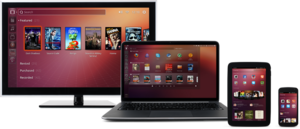PC WORLD [19/02/13]
 Among the most notable features offered by Ubuntu for tablets
are a new capability Canonical calls “side stage” multitasking along
with full disk encryption, multiple secure user accounts, and
convergence across phone, tablet, TV, and PC form factors.
Among the most notable features offered by Ubuntu for tablets
are a new capability Canonical calls “side stage” multitasking along
with full disk encryption, multiple secure user accounts, and
convergence across phone, tablet, TV, and PC form factors.“Multitasking productivity meets elegance and rigorous security in our tablet experience,“ said Mark Shuttleworth, founder of Ubuntu and Canonical. “Our family of interfaces now scales across all screens, so your phone can provide tablet, PC and TV experiences when you dock it. That's unique to Ubuntu and it's the future of personal computing.”
The Ubuntu “side stage”
Fans of Ubuntu Linux may remember that the phone interface software unveiled in January was notable for its use of all four edges of the screen.
That's part of the tablet interface as well, but the tablet version also introduces the Ubuntu “side stage” as a way both to enable efficient multitasking and to improve the usability of phone apps on tablets. Accordingly, users of Ubuntu for tablets can run both a phone app and a tablet app on the screen at the same time.
So, “you can tweet while watching a movie,” for instance, or “take notes while surfing the Web,” Shuttleworth explained in a press briefing this morning.
Enterprise-level security
Particularly compelling from a business perspective are the security features included in Ubuntu for tablets.
Not only is full-disk encryption available for the device itself, but there's also full encryption of personal user data, making the device eminently suitable for use by multiple different users in an enterprise setting.
 Ubuntu can offer a full PC experience when the tablet is docked to a
keyboard, with access to remote Windows applications over standard
protocols from Microsoft, Citrix, VMWare, and Wyse.
Ubuntu can offer a full PC experience when the tablet is docked to a
keyboard, with access to remote Windows applications over standard
protocols from Microsoft, Citrix, VMWare, and Wyse.“We expect to see Ubuntu tablets being adopted initially in enterprises, with multiple users for a single tablet because the tablet gets passed around,” Shuttleworth explained. “And because it's just Ubuntu, it's completely manageable from the same tools people are using to manage desktops and cloud today.”
'A single app binary'
Finally, the tablet interface is powered by exactly the same code that provides Ubuntu's phone, PC, and TV interfaces, enabling true device convergence.
“The exact same code will give you the same experience depending on the hardware you boot it on,” Shuttleworth explained. “It responds to the hardware and presents the optimal user experience for that device.”
Not only can the operating system itself scale smoothly across all form factors, in fact, but so too can the apps developers create for it. “Developers can then write a single app binary that can run on phone, tablet, PC, or TV,” he added.
That convergence is expected to be complete by Ubuntu 14.04 LTS, due in April of next year, Shuttleworth said.
A 'Touch Developer Preview'
The Ubuntu tablet interface supports screen sizes from 6 to 20 inches and resolutions from 100 to 450 ppi.
This Thursday Canonical will
release a “Touch Developer Preview” of Ubuntu, with installation
instructions for the Nexus 7 and Nexus 10 tablets as well as smartphones
including the Nexus 4 and Galaxy Nexus. Installable images and source
code will be available from Ubuntu's developer site.

No comments:
Post a Comment